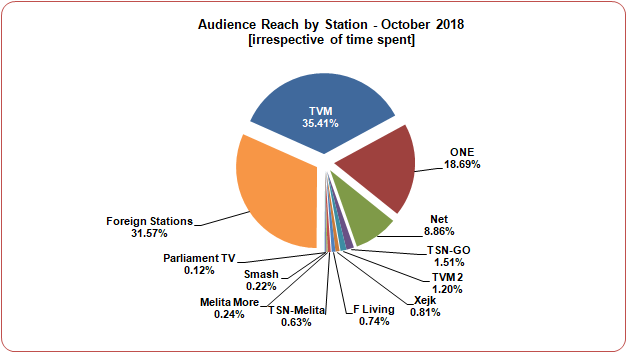Release: Immediate
Date: 18th December 2018
PR 09/18
BA SURVEY REGISTERS TELEVISION AND RADIO AUDIENCES SHIFTS
The Broadcasting Authority has released the audience assessment survey for October 2018.
For this assessment forty daily questionnaires were compiled by the NSO giving a total sample of 1,240 respondents with the youngest being 12 year olds. Overall, this sample gives a margin of error of ±2.78%. The data was analysed demographically by gender, by age-group, and by six geographical districts.
The audience survey took place during the whole month of October 2018.
Watching TV
As many as 274,000 persons (aged 12 years and over), or 60.7% of the population followed television regularly during October 2018. Compared to previous data, there was an increase of 4.9% of viewers over the previous assessment period of July 2018 and a minimal decrease of 1.0% over that of the same period last year (October 2017 – 64.7%). However it has to be pointed out that for the assessment of October 2017 12-15 year olds were not interviewed.
The average number of hours spent watching television amounts to 1.84hrs per viewer. This was just 36 seconds less than that registered during the previous assessment in July 2018 [1.85hrs] and 17’24” higher than that of the same period last year [October 2017: 1.55hrs]. Over the whole of the population aged 12 years and over, average viewing was at 1.70hrs which was 11’24” higher than at the previous assessment of July 2018 [1.51hrs] and 35’24” higher than that of the same period last year [October 2017: 1.11hrs].
Television Audiences
TVM has attracted the largest number of TV-viewers (35.41%) with approximately 141,000 viewers. This station was followed by ONE with 18.69% (≈75,000); Net TV with 8.86% (≈36,000). The other local TV stations’ reach ranged between 0.12% and 1.51%. Furthermore, 31.57% (≈126,000) of the population followed a foreign TV station. On average TV viewers spent a total of 1.44hrs every day watching their favourite programme.

Respondents were asked what type of programme they like to watch on local television stations. Local & Foreign News were the most favorite programme genre [26.3%]; Drama programmes ranked second [16.4%]; Discussion & Current Affairs programmes ranked third [11.1%]; folllowed by Cultural/Eductional programmes [8.4%] and Sport programmes [18.2%]. The other categories named by respondents were as follows:
|
Documentaries
|
–
|
7.6%
|
|
Light Entertainment/Comedy/Games
|
–
|
7.0%
|
|
Music Videos
|
–
|
5.8%
|
|
Religious
|
–
|
4.3%
|
|
Teleshopping
|
–
|
2.5%
|
|
Children's
|
–
|
2.3%
|
Analysed by gender, male preferences exceeded female preferences mostly for sports programmes [M:31.7%; F:7.6%] followed by Local and Foreign News [M:65.2; F: 61.6%]. Preferences slightly differed between males and females for Music Videos [M: 14.0%; F: 13.9%] and Documentaries [M:18.3%; F: 18.5%]. Female preferences exceed male preference for Drama by 23.2% [F:51.4%; M:28.1%]; Religious programmes by 7.4% [F:14.2%; M: 3.8%]; Light Entertainment by 6.7% [F:20.3%; M: 13.5%]; and Teleshopping by 6.6% [F:9.3%; M: 2.7%]. The differences between gender for Cultural/ Educational programmes, Children’s Programmes, and Discussion/Current Affairs programmes was of 3.0% and less.
The most common service for watching television is that of a paid subscription [90.1%], followed by IPTV streaming [eg. Netflix – 16.8%]; 2.4% of the population said that they have only a free-to-air service.
Radio Listening
On the other hand, radio listening has increased by 2.1% to 237,000 persons. While in February 212,000 persons (aged 12 years and over) listened to radio regularly, in July this figure rose to 225,000 persons (February: 50.9%; July: 53.0%).
During July, radio listeners spent an average of 3.16hrs every day following their favourite radio station. This was 12 minutes more than the assessment of February (2.99hrs) and 15 minutes more over that of the same period last year (July 2017).
Radio Audiences
In general radio listeners tend to follow one particular radio station. However, there are two ways of measuring radio audiences:
– by popularity or how many listeners followed each particular radio station; and
– by listenership which takes into consideration the amount of time that each listener spent following a particular station.
By popularity:
89.7 Bay has attracted the largest number of radio listeners [22.39%] with ≈56,000 listeners. This station was followed by ONE Radio with 17.61% of all listeners [≈44,000]; Vibe FM with 10.6% [≈27,000]; and Radju Malta [9.82%; ≈25,000].

89.7 Bay was the most followed station by all those under fifty years old – with nearly 74.6% of 12-20 year olds; more than a third of 21-30 year olds [38.52%]; and 29.33% of all 31-50 year olds following this station. On the other hand, ONE Radio was the most followed station by all those over fifty years old – with just below a third [32.97%] of all 51-70 year olds and just above a quarter of all 71+ year olds [26.4%] following this station.
By Listenership:
Bearing in mind the amount of time that listeners spent following their favourite programme on radio, ONE Radio ranked first with 28.4% of all audiences, followed by 89.7 Bay [14.3%]; Calypso Radio [12.6%]; Radju Malta [8.6%]; Radju Marija [7.5%]; Vibe FM [6.8%]; Net FM [6.0%]; RTK [3.5%]; Magic Malta [3.1; %]; XFM [2.5%]; Campus FM [1.2%], while the rest had less than 1% of all audiences.

The full version of the results of the survey can be downloaded from the Authority’s website.
Mario Axiak, M.B.A (Maastricht)
Head, Research & Communications
18th December 2018
Click here for the full Assessment of October 2018
Click here for previous assessments